By Ives de Saeger and Eddy Claeys
Abstract
The first part of this article discusses the 40 inventive principles, a tool of classic TRIZ (Theory of Inventive Problem Solving). The authors compare the 40 inventive principles from different English TRIZ sources and note the differences between them – incomplete principles, word usage and differences in translations. The second part of the article discusses how the 40 inventive principles (IP) can be used differently. The authors explain different approaches to using the principles in a straightforward manner so the principles are less abstract. They aim to simplify the application and strength of the principles by dividing them into two parts – resource and recommendation. Since language triggers thoughts, different meanings can create different interpretations. To standardize the language the authors also suggest using the revised 40 inventive principles with more systemic terms. After comparing the principle sources, a divided principle is applied to an example.
Keywords
40 inventive principles, resources, recommendation, operator
Introduction
The contradiction matrix is a widely known TRIZ tool. Although Genrich Altshuller, the father of TRIZ, worried about the effectiveness of the contradiction matrix and the 40 inventive principles, the principles still inspire TRIZ students.1,2 Other tools have followed such as the inventive standards and ARIZ (an algorithm of inventive problem solving).
Darrell Mann rearranged some of the principles and developed a new overview of the matrix. He combined some principles and added others, and the number of parameters changed from 39 to 47.3,4 An interesting feature added in the 2003 matrix is a linear link between parameters and recommended inventive principles.
Comparing the 40 Inventive Principles
The inventive principles have changed due to the work of many TRIZ specialists and there are many sources available when studying the principles. In a May 1998 article in The TRIZ Journal, William Todd and Ellen Domb described possible symmetries between the 40 inventive principles; another TRIZ specialist defined additional inventive principles when looking for similarities between the principles and different patents.5,6 As previously mentioned Darrell Mann grouped the principles into a 5x3 matrix by space-time-interface entities.3
The sources used for the comparative analysis of the inventive principles were:
A. Genrich Altshuller's book, Forty Principles, translated by Lev Shulyak12
B. Invention Machine Company Techoptimiser 3.0
C. Ideation Innovation Workbench, version 2.8.0
D. Darrell Mann's book, Hands-on Systematic Innovation3
E. A TRIZ Journal article written by Ellen Domb in 1997, "40 Principles with Examples"14
The authors selected Altshuller's Forty Principles as a reference because of its historical significance and because it contains 98 inventive principle subdivisions (IPS). A limited number of sources were randomly selected along with Lev Shulyak's version. The authors used the sources to compare information, word usage, vocabulary, technology and defined starting conditions. The following is a comparative summary of the inventive principle subdivisions derived from the sources:
- Seven IPS have been added to the reference
- 43 IPS have additional information
- Three IPS are not included by the others
- Three other IPS are not mentioned by all the other sources
While the authors compared 107 IPS, Table 1 shows a comparison of principle 39.
| Table 1: Comparison of Principle 39 |
| | Comparative Analysis Sources |
| IP | A | B | C | D | E |
| 39 | A. Replace the normal environment with an inert one | A. Replace a normal environment with an inert one | A. Replace the normal environment with an inert one | A. Replace a normal environment with an inert one | A. Replace a normal environment with an inert one |
| | B. Introduce a neutral substance or additives into an object | B. Add neutral parts or inert additives to an object | | B. Add neutral parts or inert elements to an object or system | B. Add neutral parts or inert additives to an object
|
| | C. Carry out a process in a vacuum | | B. Carry out the process in a vacuum | | |
The sources for the 39 IPS use a variety of different words all with the same meaning, for example – object, system, structure and environment, stationary and fixed. 28 IPS within the same principle had different meanings – separate, single out, consolidate, combine or make. Using the first IP, Table 2 shows some of the different terms. Translations and different dictionaries affect the meaning of some words.
| Table 2: Differences in Meaning |
| | Comparative Analysis Sources |
| IP | A | B | C | D | E |
| 1 | A. Divide an object into independent parts | A. Divide an object into independent parts | A. Divide an object into independent parts | A. Divide a system into separate parts or sections | A. Divide an object into independent parts |
| | B. Make an object sectional (for easy assembly and disassembly) | B. Make an object easy to disassemble | B. Make an object sectional | B. Make a system easy to disassemble and reassemble | B. Make an object easy to disassemble |
| | C. Increase the degree of an object's segmentation | C. Increase the degree of fragmentation (or segmentation) of an object | C. Increase the degree of an object's segmentation | C. Increase the amount of segmentation | C. Increase the degree of fragmentation or segmentation
|
Technology and the Undefined Solution
The authors use "technology" when a technical solution is proposed in the IPS. The term "undefined solution" means that no technical solution, or the means to perform the solution, has been proposed. For instance, if a practitioner wants to divide a system into independent sub-systems the question remaining is how to perform the division. What specific method should be used to divide the system? A principle is called an "undefined solution" if it is not clear which technology is used to divide the system. Some principles, however, suggest what to do and what technology to use, for example number 14B, "use rollers, balls, spirals, domes" and number 18, "use piezoelectric vibrators instead of mechanical ones." Yet the authors found most of the principles were abstract in terms of how to actually perform the tasks. Nineteen IPS described a clear technology, 88 IPS were abstract. The authors concluded a degree of abstract thinking is required when using the inventive principles; the user must apply the abstract principle to a given problem.
Description of the Starting and End Conditions
Some inventive principles describe the starting condition. For instance principle 39A states "replace the normal environment with an inert one" and 29 says "replace solid parts of an object with a gas or liquid. These parts can now use air or water for inflation, or use pneumatic or hydrostatic cushions." These examples indicate a defined starting condition. In IP 39 it is called a "normal" environment. In IP 29 solids are the starting condition. The 66 IPS had only a formulated "end condition," while 31 IPS contained an initial condition. Consider the five sources as three versions: A and C are similar, and B, E and D are different.
Limits to the Inventive Principles
As soon as a technique is applied the user will face two conflicting parameters:
- Limiting the user to using both at their maximum – a technical contradiction and
- A conflicting parameter where extremes are needed – a physical contradiction.
An inventive principle should help the user find a new way to solve the conflict. The inventive principles should act as an enhancer stimulating the different possibilities for overcoming the current unsolvable problem. Pictures, movies and examples can make the inventive principles less abstract. There are many papers that clarify how to use the inventive principles in specific domains. A lack of knowledge in a specific scientific area, however, can hinder TRIZ practitioners and they may overlook possible solutions. Misunderstanding a word or explanation and an inability to think abstractly can also impair usage of the inventive principles. Not only must practitioners decide what direction to go, they also have to implement the solution. Theory of constraints developer Elihu Goldratt refers to this as the transition tree – going from the current to the future reality tree.15 The solution can be clear, but the implementation changes for the solution can be another obstacle. And the inventive principles lack implementation solutions.
Strengthening the Inventive Principles
The 40 inventive principles serve as problem solving resources. The authors divided the 40 inventive principles into two parts – resources and recommendation. Most inventive principles include a hint of where or what the problem is, and an idea of how to solve the problem – the recommendation. While convenient to have a common language, the authors considered it a separate problem and not essential to dividing the principles into the two parts. Therefore, the following example does not use a uniform language. The authors instead used a common vernacular for the inventive principles based on classroom settings.
In the following example the authors used the term systems instead of objects, because a system is broader and can include one or several objects. Every problem needs a clear definition of what the system is and the context of the problem (operational zone and time). A sub-system is a part of the system and is used instead of parts. Environment and surrounding are referred to as super-systems – everything that is not part of the system, but could affect the system and in some way interacts with the system. The words "actions" and "operations" were replaced with "processes." A process changes the state in which a system relates to another state – it changes the attributes/properties of an object. Parameters and characteristics are called properties, and a factor is a function or property. The authors also renamed the principles using verbs to reflect their potential for action and solution generation.
Example: Lock
Sometimes it is difficult to define a contradiction, but there are many sources available to assist the practitioner. Altshuller's book Forty Principles offers assistance on how to formulate contradictions.7 Valeri Souchkov developed a clearer way to formulate contradictions.11
TRIZ experts Kalevi Rantanen and Ellen Domb formulated a contradiction example in their book, Simplified TRIZ, that was based on the sinking of the Estonia in 1994 that resulted in 852 deaths.13 Investigators concluded that a locking mechanism on the ship failed. Figure 1 shows the simplified locking mechanism. The technical contradiction is between the reliability of the lock versus the ease of opening and closing the lock.
| Figure 1: Examples of an Open and Closed Lock |
| 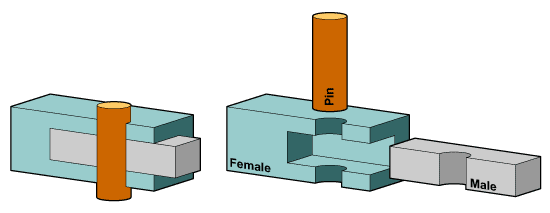 |
|
|
| Figure 2: Technical and Physical Contradictions |
| 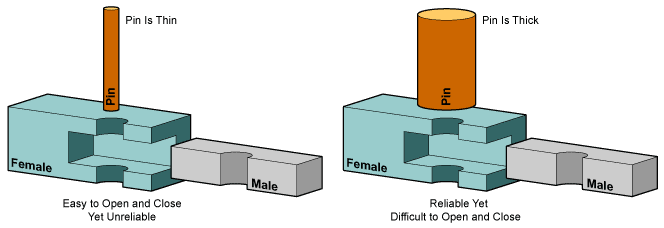 |
|
|
To solve the contradiction TRIZ practitioners use the following inventive principles:- 17, other dimension
- 14, curvature
- 15, dynamization
- 10, preliminary action
Inventive principle 17 suggests:
- If an object moves in a straight line consider dimensions or movement outside the line.
- If an object contains or moves in a plane consider dimensions or movement outside the current plane.
- Stack objects instead of a using only a single level arrangement.
- Re-orient the object or system – lay it on its side.
- Use a different side of a given object or system.
The five inventive principle sub-systems from IP17 contain clues formulated through the words: plane, moving, dimensions and single-level arrangement. The drawing helps define planes, sides and movement. In the drawing there are:
- Fifty-six sides (pin, female male)
- Two linear moves
- Twenty-eight planes
IP 17 also suggests what to do (operators): if an object moves in a straight line consider dimensions or movement outside the line. An example is to curve the line of the male as in Figure 3.
The next step is to adapt the design to deliver its function as shown in Figure 4 by changing the female to the opposite form. This step occurs after applying the inventive principle recommendation.| Figure 4: Impact of a Curved Male on Design |
| 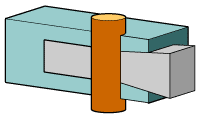 |
|
|
Other possible changes are shown in Figure 5 – change the line or movement of the sub-systems.| Figure 5: Different Solutions of Movement Change and Curves |
| 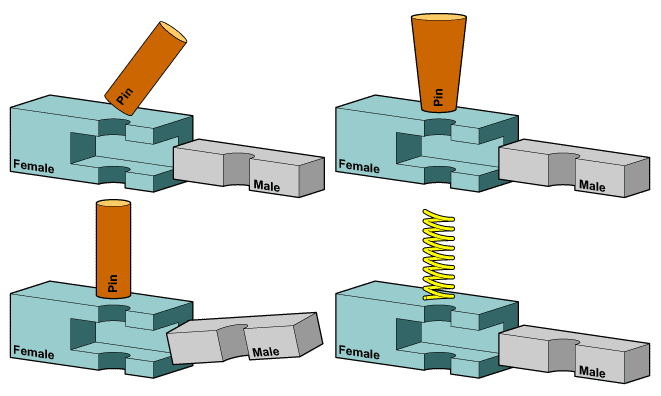 |
|
|
If an object moves in a plane consider the dimensions or movement outside the current plane as viewed in Figure 6. | Figure 6: Two Solutions for Changing the Plane |
|  |
|
|
Figure 7 shows how stacking the objects can change the system.| Figure 7: Stacking Arrangement |
| 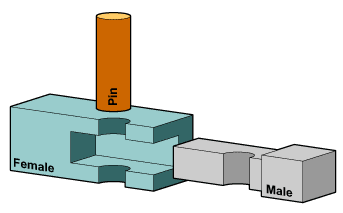 |
|
|
Re-orient the object or system. Lay it on its side as portrayed in Figure 8.
| Figure 8: Re-oriented Lock |
| 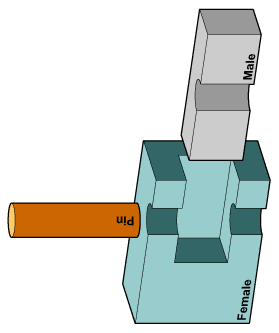 |
|
|
The last solution is different, because it cannot be completed without knowing the super-system. Use a different side of a given object or system. Figure 9's solution leads to a key concept – the example shows that by dividing the principles into resource and recommendation parts the user can find the solutions through a step-by-step approach. Taking this a step further principle 17 could be reformatted as "use another dimension."
- Resources:
- Define all sides, directions of the system
- Define distances (x, y, z) and angles (a, b ,g)
- Define all planes
- Define the arrangement with other systems
- Operate to:
- Change a system from one to two- or three-dimensional space
- Use a multi-story arrangement of systems instead of a single-story arrangement
- Tilt or re-orient the position system – lay it on its side
- Use "another side" of the system
Figure 10: Solution from U.S. Patent 5.875.658 25/9/199
Locking Mechanism for Gates and Hatches |
| 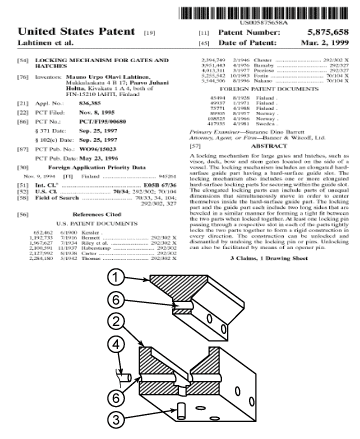 |
|
|
Summary
The comparison of the 40 inventive principles from different English TRIZ sources as described in books or software results in minor differences such as incompleteness of some principles and different translations (probably due to the use of different dictionaries). Technical solutions are rarely provided so the principles can be considered abstract. The authors encouraged TRIZ practitioners to look at the principles differently, so they appear less abstract and more usable without undergoing fundamental changes. Dividing the principles into a resources and recommendation part will make them easier for practitioners to use.
References
- Khomenko, N., and Ashiani, M., "Classical TRIZ and OTSM as a Scientific Theoretical Background for Non-typical Problem Solving Instruments," TRIZ Future 2007.
- Mann, Darrell, "Evolving the Inventive Principles," The TRIZ Journal, August 2002.
- Mann, Darrell, Hands-on Systematic Innovation, CREAX Press, 2002.
- Mann, Darrell, Zlotin, B., Zusman, A., and DeWulf, S., "Matrix 2003: Updating the Contradiction Matrix," CREAX Press, 2003.
- Williams, Todd, and Domb, Ellen, "Reversibility of the 40 Principles of Problem Solving," The TRIZ Journal, May 1998.
- Cong H., and Tong, L. H., "Similarity Between TRIZ Principles," The TRIZ Journal, September 2005.
- Altshuller, Genrich, Forty Principles, translated by Lev Shulyak, Technical Innovation Center, Worcester, MA, 1998.
- Invention Machine Co. Techoptimiser 3.0.
- Ideation Innovation Workbench software, version 2.8.0.
- Domb, Ellen, "Contradictions:Airbag Applications," The TRIZ Journal, July 1997.
- Souchkov, Hoeboer, Zutphen, "Application of RCA+ to Solve Business Problems," The TRIZ Journal, February 2007.
- Altshuller, Genrich, and Clarke, Dana W., 40 Principles: TRIZ Keys to Innovation [Extended Edition], translated by Steve Rodman.
- Rantanen K., and Domb, Ellen, Simplified TRIZ: New Problem Solving Applications for Engineers and Manufacturing Professionals, CRC Press, 2002.
- Tate, K., and Domb, Ellen, "Forty Inventive Principles with Examples," The TRIZ Journal, July 1997.
- Goldratt, E., Critical Chain, North River Press, 1997.
This paper was originally presented at the European TRIZ Association's TRIZ Future 2008 meeting in Enschede, NL.
About the Authors:
Ives de Saeger has a degree in Physics and and is also a Civil Engineer. Following a varied career involving all aspects of industrial engineering and process improvement, he is now the General Manager of P41, a leading edge consultancy on process innovation. He has worked with VW, Daf Trucks, Johnson Controls, Daikin, Volvo Trucks, Atlas Copco, Picanol, Euromold, Malmar, Alro and more. de Saeger's blog can be found at http://processinnovation.blogspot.com/. Contact Ives de Saeger at ids (at) p41.be or visit http://www.p41.be.
Eddy Claeys works at P41 Partners In Process Innovation, Belgium.
Copyright © 2006-2011
– RealInnovation.com, CTQ Media. All Rights Reserved
Reproduction Without Permission Is Strictly Prohibited –
Request Permission
Publish an Article: Do you have a innovation
tip, learning or case study?
Share it
with the largest community of Innovation
professionals, and be recognized by your peers.
It's a
great way to promote your expertise and/or build your resume.
Read more about submitting an article.